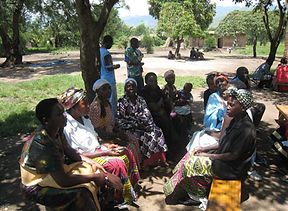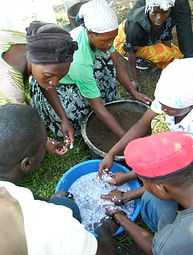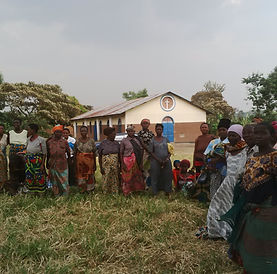
From 8 to 40 in 12 years.
During our first visit and mission in 2005 we were moved by how hard the women had to work to survive and bring up their children. Many were widows either through HIV or warfare. Daily, they walked miles to collect water, farmed their small plots of land (if they had land) to grow cassava and beans, as well as looked after their children. Many of the children were not in school because the women couldn't afford to buy uniform or books and needed older children to help at home.
We wanted to do something to support these women in raising themselves out of abject poverty.
Our Vision is to help women:
-
Raise their families out of poverty by feeding and educating the family
-
Earn income through small businesses and skills training
-
Become committed Christians
-
Bring up children to be leaders of integrity
-
Be sustainable
-
Increase their confidence and self esteem
-
Work together to be stronger as a team
Our first project, when we began our work in Uganda in 2006, was to start 8 micro-finance women’s groups. Each group of 20 women was trained for 6 months in book keeping, running small businesses and crafts. Alongside this training the women met weekly in fellowship and bible study led by one of the Ugandan evangelist team.
Following training the groups received a micro-finance loan from Amaha We Uganda, (or Hope for Uganda as it was then), to set up a small business using the skills they already had.


One of our first women's groups in Kapatunda.

Jim and his dancing partners 2008
Seven of the eight groups flourished and their enthusiasm was inspiring.
Seven groups repaid 100% of their loans within the first year and the eighth group 65% so that the money could be recycled to start new groups.
The groups continued to flourish and by 2012 there were 30 groups. Each of these 30 groups were shadowed by 30 other groups who recognised how successful they could be as a team.






First women's conference ,Ibanda, Rwenzori Mountains. 2007 (above)
All Saints groups Kasese, making paper beads (below)

All Saints groups Kasese, in their new uniforms, praising God (below)

All Saints groups Kasese, meeting in fellowship (below)

Lhuwhawha groups 2007 (right)





Kajwenge groups 2008 (above)




Women's conference 2010 (above)
Lhuwhawha group 2008 (far left)
Kapatunda group 2008 (left)

Walking home after Women's conference 2010 (above)




Kapatunda 2013 (top right) Bwera 2013 (middle) Kitswamba 2013 (top left)
Sharing the love and joy in Kajwenge 2013 (left)
Women and street boys making briquettes together 2013 (right)

Such joy 2014 (below)






Kinyamaseke 2015 (right & middle)
Kapatunda 2015 (above)
When we return every year we see our fellowship with the woman has grown. We learn so much from their commitment and their faith. Each woman has used their loan for small businesses; selling crafts, growing crops, breeding animals, buying wholesale from the farmers and selling produce locally,cooking and tailoring. This has enabled them to make a small profit to help feed their families and send their children to school. The longest established groups are on a third round of loans which they pay back at a small rate of interest. All the repaid loans go back into a revolving fund to start new groups. The women all claim that they have been able to lift themselves and their families from the bottom tier of poverty and that all their children attend school. Lots of children continue in secondary education and some are attending university. The women are confident, happy and are shining lights in their communities. For more on their personal testimonies read their blogs here
In 2018 there are 40 groups supported through Amaha We Uganda. We estimate some 15,000 children have benefited from these micro-finance groups.
The latest mission in 2016 (below)



The journey of the women's groups' continues year on year. There are now 42 groups (as of 2020). To keep up to date read the blog.
